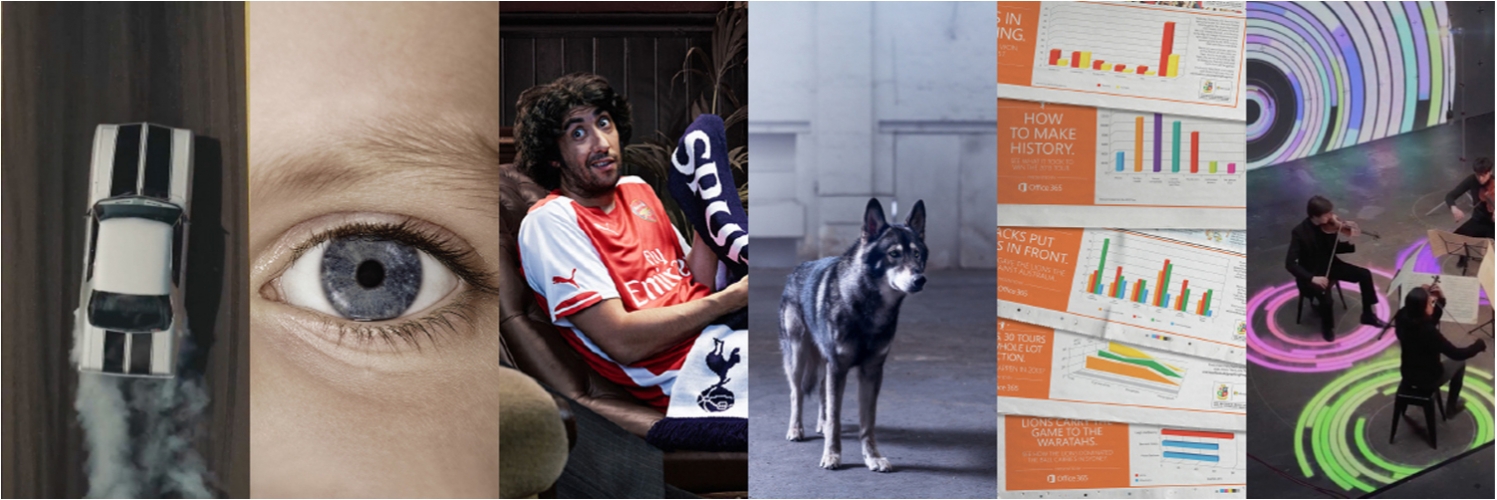With the so-called 'Great Resignation' having wiped through several markets and many sectors, there is likely to have been an impact on creative industries. Which means as things start to clamber out of the mire this year, there could be opportunities for people to move into a creative industry from other semi-related or unrelated roles.
But, there's a catch.
There is no shortage of online articles espousing the tips and tricks for landing that dream job. The problem is they’re almost always written for regular office jobs, focusing on cover letters and tie colours.
What about creative roles in advertising, media, digital and gaming industries? While pointers on interview etiquette are still essential for seeking a creative job (Gen-Z take note), the requirements of a creative role make the criteria of the process different, and therefore the requirements of the applicant.
As an Executive Creative Director in advertising, I’m often on the look out for new talent. When my agency has an open creative role and I find myself wading through CVs, it never ceases to amaze me the mistakes young creatives and wannabe-creatives make in their applications.
Below is a list of the most common – and they really are incredibly common – bugbears that immediately move an applicant into the ‘out’ pile. Every single one of these it true. I've seen them time and time again. Avoid all these issues to dramatically improve your chances of success.
1. Where’s the work?

It baffles me when creatives apply for roles without a portfolio. When you’re a bonafide working creative, your portfolio is your life. Everything you do in a job is focused on ensuring you produce great work (ideally award-winning). Your portfolio shows others what you are capable of. It is the proof of your pudding.
My process – probably not unlike that of other ECDs – is to look at the applicant’s portfolio first and foremost. If it doesn’t have good/great/interesting work, then the CV probably doesn’t even get read (see also Point 6).
No portfolio?
Straight to the ‘no’ pile.
If you’ve already had a creative role, then you should have work to show for it. And if you don’t think your work is good enough, include proactive and spec samples that prove your capabilities, alongside some of the genuine work to show you’ve got some experience (and are looking to make it better with great creative work).
If you’re just starting out and don’t have any work, you need to come up with something – scamp ads and ideas for creative roles (wannabe Art Directors and Copywriters), some examples of writing ability for writer roles, designs for designer roles, spec game designs for... well, game designers. Show that you want this career and have a talent for it (see also Point 5).
2. Lost in the Ether
It used to be standard practice for creatives to ‘shop around their book’, calling agency after agency to arrange a string of appointments with ECDs and then schlepping around from one to the next to sit on a couch while these exalted luminaries thumbed through your pages at a rapid pace, as you silently hoped they’d spot something that made them pause long enough to indicate you had something they liked.
Or, you’d package your portfolio and send it to the ECD (via their PA) in the vain hope they eventually find 30-seconds in their day to open it, with the trick being to package the folio in such a way as to attract attention.
These days, it’s all emails and attachments, which flow to an inbox among the daily deluge of digital communications, have no way of attracting attention and get lost in the ether.
Knock on doors. Literally.
While online folios and emailed CVs are standard formats when applying to job advertisements, sometimes you need to go through the cold-call process of looking for an opportunity. In this case, you aren’t doing yourself any favours by emailing from the comfort of your couch.
You’ve got to get yourself – and your folio – out there, on the streets and to the faux-woodgrain desktops of ECDs and senior creatives. Meet people. Show eagerness. You just may walk into an agency at the right time, and if not, you'll be on their radar when they do need someone.
But don't follow a prospective employer to the coffee shop. Or their home. That's call stalking. It's illegal. And creepy.
3. Typograhpical Erorrs

Nothing shows a lack of attention to detail more than a CV that lists capabilities including ‘attention to detial’. Yes, I actually read this ironic typo in a CV for a copywriter.
Sure, mistakes happen. But when your CV is your sales pitch, your proof of quality, you can’t afford such mistakes. Especially when they’re easily prevented by spellchecking your document and proofreading.
A tip for proofreading:
read it once, then read it again,
but this time backwards.
When you read forwards, your brain has the uncanny abilty to corectly read mispeled wrds by contxtualising each wrd wth th wrds eithr side of it. By going backwards, from bottom to top, last word to first, you disrupt the context and force your brain to focus on each word individually.
But worse than the occasional erroneous typo is a complete disregard for grammar, sentence structure, or the English language. Beyond the primary task of a creative to have ideas, they also need to communicate, build presentations, and present to stakeholders. If you write your CV like a 13-year old TXTs, then that’s the impression you’re going to leave. No-one wants to leave a client brand in the hands of a teenager speaking emoji, LOL.
4. What’s a JD?
In response to an ad for a “Shit Hot Creative Team in Sydney” which clearly asked for agency experience and a portfolio to show it, I once received a CV from a former chef turned telesales operator. In Mumbai. No kidding.
While this is an extreme example, it is merely the tip of the iceberg of obviously inappropriate candidates. Even if you’re going for a career change, or playing the odds out of desperation, you need to be honest with yourself on your suitability for a role, and how to pitch it.
You might be wasting the time of the hiring employer, but you’re also wasting your own time which should be better spent improving your CV, applying for the right roles and landing an appropriate job.
Read the job ad carefully.
If you have the required skills but your current CV doesn’t quite show it, then make the necessary changes. There is no ‘one size fits all’ CV. Build your master version, then tweak it to match the requirements of the role, the company or even the person who’ll be reading it.
The same goes for your portfolio. If you’re applying for a role at a digital agency, then your TV scamps take a back seat to your tech ideas.
5. Training Day

It’s admirable that newbies fresh out of school want to get a creative job. But these roles are harder than many people think. In advertising, it's not enough to be able to just have wacky ideas.
You’ve got to think strategically, understand consumer psyches, know behaviour triggers, adhere to a brand’s tone of voice and guidelines, know what those things are, know the rules of advertising, have ideas that tick many corporate boxes while still being ‘out of the box’, and be able to logically express the suitability of those ideas for the brand’s business objectives.
Likewise, while many people think they have a great idea for the next Angry Birds or GTA, you need to know game dynamics, levelling, an understanding of dev, reward mechanics, storylines, and a whole lot more.
Your marketing diploma from the University of Toffeenose (Hons.) might have taught you about the industry in which you plan to make a career, but it takes a long time to learn all the skills required to actually make it a career. Most tertiary courses don’t prepare you for a creative role, or assess your ability at being creative with any real lens of marketability or practicality.
Complement your tertiary qualifications
with short courses.
Many will be available for any industry and cover a wide range of practical components. These courses can teach the basics of creative ideation techniques, consistency of thinking, how to read briefs, how to judge one’s own ideas, what makes a great idea, what makes a viable idea, applying ideas to media, and much more.
Possibly the most important lesson of these courses is that of rejection – having your ideas critiqued, sometimes harshly, by an experienced practitioner. This will teach you to try again with more passion, more direction, more purpose, and more understanding.
Plus, students often leave these courses with additions to their portfolio that (hopefully) show how good they are. Don't forget to add the details of these courses to your CV.
I almost never hire a junior creative who hasn’t done one of advertising's creative courses (Miami AdSchool, AWARD School, Creative School). Seek them out, apply, apply yourself, graduate, then apply for jobs.
6. Upskillz
If your portfolio is good, then your CV gets read to provide background information and perhaps a little personal character. If the CV is good, then you get a job interview.
While your CV is mostly a chronological record of your employment and education, it’s actually an insight into what you can bring to your employer. A bachelor’s degree is good – it shows intellect and application – but a diversity of useful skills mean you have added value.
Your Summer job at the pizza place doesn’t count unless you can still get unlimited free pizza for life. What your potential employer is looking for are creative abilities that could be applied to the job if needed, especially given the ever-tightening budgets and ever-broadening demands of clients.
Extra-curricular activities
with an obvious creative application
are always a benefit.
If you can sketch and draw, you could bring storyboarding skills in-house. If you’re in a band, you may be able to provide music to a project that would otherwise remain silent. If you make your own short films, you could be a handy resource for that proactive job they need to get done or content creation. If you prototype your own tech, you’re more than a digital native.
7. Dear <insert name here>

I once received a job application that, despite its enthusiasm, opened with the salutation 'Dear Max.'
That's not my name!
Get the employer's name right, for Pete’s sake. Especially if his name is Pete. This could be your new boss, goddamit.
8. Geographically Challenged
It’s exceptionally difficult to apply for roles in a different country from where you live. Senior creatives and Exec Creative Directors can do it because they have built a reputation and a network, and they’re usually poached by the company from overseas.
But if you’re just starting out and trying to get a junior creative role or an internship in another country, it’s probably not going to happen. Firstly, there are legal complications for a company trying to hire foreign staff, from proving they haven’t found a suitable candidate locally to the management of visas.
Secondly, it’s an added expense and responsibility particularly if sponsorship is required, but also for the actual process of the job application with videocall interviews and the need to meet in person before the contract is offered.
None of this will happen for junior roles. And you’ve got to be damn good for it to happen with mid-weight roles. If you’ve got the experience, the portfolio, the awards, and the reputation, then you won’t be reading this article.
9. Pants on Fire

Your CV and portfolio are your personal advertisements. They need to paint as positive a picture of you as possible. Just like a brand only tells you the good stuff about their products and services, embellishing where they can and glossing over or hiding the flaws, your CV needs to do the same.
And in the same way those brands cannot falsely advertise, neither can you.
Your portfolio can include the ‘director’s cut’ of a TV commercial, your preferred version of a gaming character, your original packagind design before the budget got halved. ECDs know all too well how frustrating it is when external decisions and factors impact on what could have been a great piece of work.
It’s OK to include work that never ran – those concepts and ideas that never saw the light of day – provided they are good enough to help you get a job. You are being judged and hired on your ability to have great ideas, not just on the work that the usually uncreative stakeholders allowed to happen.
However, you cannot include work you didn’t do.
I once looked through the portfolio from a Junior Art Director and was surprised to see it included one of my very own first print ads. On that occasion, I actually invited them to an interview just to hear them talk about the thought process that developed that ad. Then I talked about that ad. My ad. Needless to say, they did not get the job.
On another occasion I received three portfolios in response to the one open role, each containing the exact same print campaign. And while it’s not uncommon for multiple creatives to work on a campaign together, it was implausible for three midweight Art Directors to all have worked on these three rather basic print ads at the same time. Especially when their CVs showed that they hadn’t ever worked at the same ad agency .
Some studies have shown
that up to 63% of CVs contain lies.
Talking yourself up is par for the course, but you cannot lie. Nor should you overstate responsibilities and capabilities. You may be expected to live up to those standards in your new role.
Finally, over-egging your CV becomes obvious. An appropriation of diffusive morphemes implementing marketing hyperbole evinces you’re endeavouring to compensate for something. If you are a Copywriter, don’t call yourself a Specialist Marketing Communicator. There’s no such job title.
10. One Reason
As a former ECD of mine once imparted as I moved up the ranks: “People aren’t looking for a reason to hire you. They’re looking for a reason to NOT hire you.”
Just don’t give them one.
Good luck. Good hunting.



